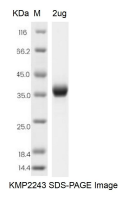Service Line:+86-022-82164980
Address:FL-4, Building A5, International Enterprise Community, Tianjin, China
Email:[email protected]
| Catalog Number | KMP2243 |
|---|---|
| Product Name | Human TNFRSF17 Protein, His Tag, Flag Tag |
| Product Description | The Human TNFRSF17 Protein(KMP2243) is produced in HEK293 Cells and the target gene encoding Met1-Ala54 is expressed with a 6His, Flag tag at the N-terminus. |
| Molecular Weight | 6.9 kDa |
| Alias | CD269, BCMA |
| Species | Human |
| Host | HEK293 Cells |
| Size | 50ug, 100ug, 200ug |
| Purification | Affinity purification |
| Purity | >95% as determined by SDS-PAGE |
| Endotoxin | <1.0 EU/ug determined by the LAL method |
| Buffer | PBS, pH7.4 |
| Uniprot | Q02223 |
| SDS-PAGE |  |
| Function | Receptor for TNFSF13B/BLyS/BAFF and TNFSF13/APRIL. Promotes B-cell survival and plays a role in the regulation of humoral immunity. Activates NF-kappa-B and JNK. |
| Background | B cell maturation antigen(BCMA) is a member of the TNF receptor superfamily. It has been designated TNFRSF17. Mouse BCMA is a 185 amino acid(aa) protein consisting of a 49 aa extracellular domain, a 23 aa transmembrane domain, and a 113 aa intracellular domain. BCMA is a type III membrane protein containing one extracellular cysteine rich domain. Within the TNFRSF, it shares the highest homology with TACI. BCMA and TACI have both been shown to bind to APRIL and BAFF, members of the TNF ligand superfamily. BCMA expression has been found in immune organs and mature B cell lines. Although some expression has been observed at the cell surface, BCMA appears to be localized to the Golgi compartment. The binding of BCMA to APRIL or BAFF has been shown to stimulate IgM production in peripheral blood B cells and increase the survival of cultured B cells. This data suggests that BCMA may play an important role in B cell development,function and regulation. |
| Storage | Aliquot and store at -20℃ to -80℃. Avoid repeated freezing and thawing cycles. |
| Note | This product is for research use only. |
| References | 1.Nature 404:995-999 (2000) 2.J. Immunol. 165:1322-1330 (2000) 3.Nat. Immunol. 1:252-256 (2000) |